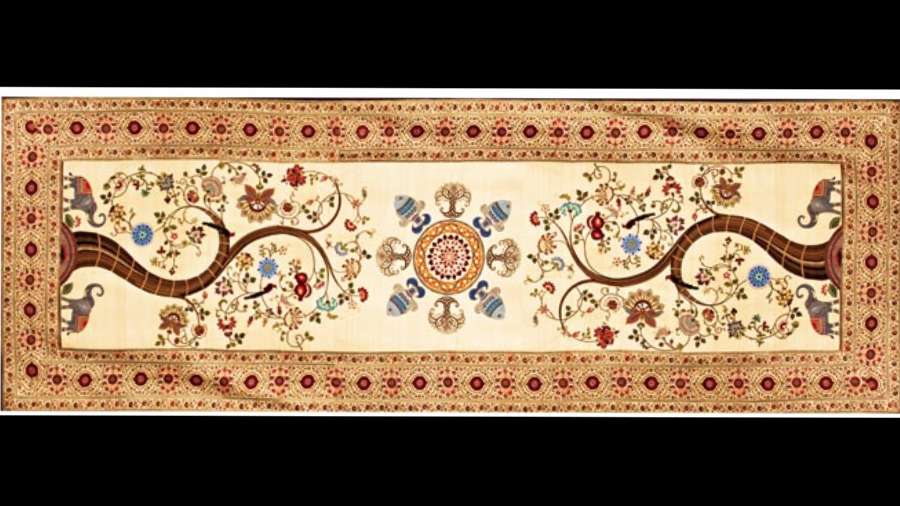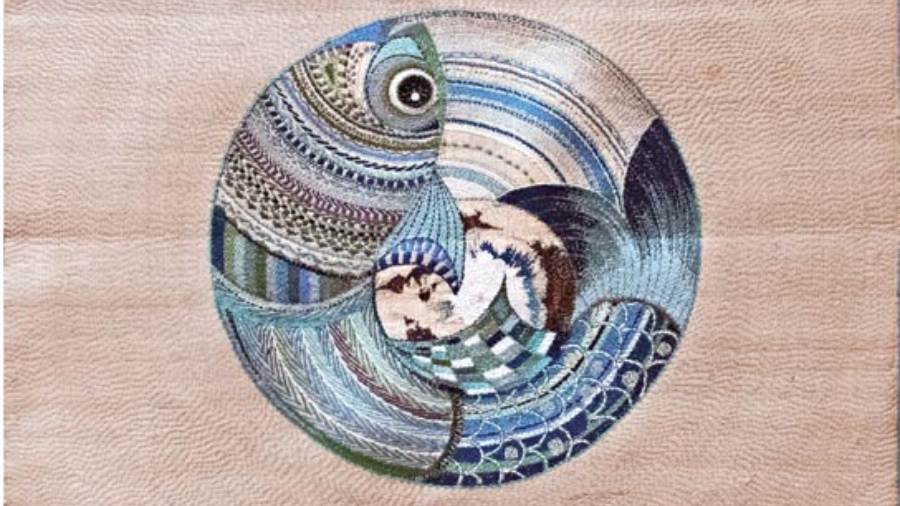During the pandemic when everyone was struggling to cope with the virus, the lockdowns, the isolations and other disastrous effects and as the human race was relying more and more on technology, Sunetra Lahiri’s mind was unfolding and spurring with new and intricate ideas for her art, which involves the magic of human touch.
Without the chores of dealing with the hustle and bustle of daily life, she found a more positive side of the pandemic. In this calmness and tranquillity, Sunetra and her karigars created the artistic brainchild, an art collection called Elemental. Refresh your vision with this experiential exhibit of art, craft and textile fusion, in the presence of the artist joined by the art director Oiendrila Ray Kapur and curator Kounteya Sinha at the Kolkata Centre for Creativity.
What inspired you to create Elemental?
The inspiration came because I was travelling and while travelling I was in an ashram and was doing a sort of meditation and when I came out of my meditation, I saw a kingfisher sitting right in front of me and looking at me and I was looking at it. Then it flew away. But at that moment I was having a eureka moment, an epiphany. So I realised at that moment exactly what I was supposed to do, what story I wanted to tell through the art pieces. I named it ‘Elemental’ because it’s a fundamental thing. We humans are made out of five elements — earth, water, fire, air and space. That’s how Elemental came about.
Apart from embroidery, what else is involved in your art style?
It has a bit of painting, it has embroidery, it has applique, whatever techniques suit a particular piece, I have done it. The main thing is to give expression to what I have thought. So whichever tools of the trade I have to use, I have used it. I work with natural fabrics, most of my pieces are on tussore and one or two pieces are on silk and organza. I try to keep everything natural.

Kalpavriksha Handwoven tussore: 90.5”x31.5”
Can you walk us through your top three pieces of Elemental ?
When we were kids, at my time, we didn’t have so many TV channels, so on Sundays we used to have a programme by Jacques Cousteau, who was a French diver and was known for many other things, and he had a team of divers who used to go to these wonderful places all over the world and he used to deep-sea dive at that point of time.
I as a kid was fascinated by the coral reefs and how beautiful it was under the sea with so many life forms, so many colours... it was hard to discern whether it was real or just a movie. But later on when I started to travel, I went snorkelling, then I found out that the underwater life was pretty real. And as a zoology student, we had portions of aquatic life, coral reefs... it was something that I was always interested in. So when I started working on Elemental, I thought I must have a piece where I celebrate the coral reefs. I named this piece after the book by French writer Jules Verne’s Twenty Thousand Leagues Under the Sea.
The second piece is called Antiquity. I believe that as an artist or an artisan all of us have grown up having a legacy which we can fall back upon and this legacy comes from our predecessors who lived maybe a few thousand years ago. I started right from the caveman and I am going on to people who have actually carved frescos, Egyptian pyramids and walls of Egyptian royal palaces as well as ancient pottery right from the pre-historic time from an area near New Mexico where they had beautiful pottery with amazing designs of grasshoppers, bugs and honeybees. So, over the years, if we look at the main civilisations like Greek, Roman, Egyptian, Aztec and the cave paintings of Venezuela, Spain and even here in Bhimbetka, it’s wonderful how with crude tools they got the motion of hunting scenes so perfectly. It’s difficult to match up to them even now with so many technology, tools and colours. I think they were a gift to art, mankind through the ages. So I wanted to pay my homage to these civilisations through this piece.
The third one is actually the culmination of the thought process of Elemental. It is called Chlorophyll and is the biggest piece and it speaks about deforestation, extinct animals, how if we don’t have forests and if we don’t have chlorophyll, there is no life, whether it’s aquatic or terrestrial. We will be extinct. One can look at it as a piece of art or can go deep inside and look at it from another perspective.

Matsya-yan
How does your art help to express yourself ?
I always wanted a bigger canvas to work on. I think making clothes were not giving me that. After NIFT, I was tired of doing the usual designing, I have done that for almost 18 years. It was not giving me my adrenaline rush. In my life, I think if there was no art and craft, I don’t know what would happen because that’s the only thing that excites me. During the pandemic and isolation, the only way I survived was to go back to my art. For those two years I literally have eaten, dreamt, slept and thought only about my craft and nothing else.
I am a kind of person who explores craft and looks at things in an artsy perspective. I look at children’s art books, great masters, Indian craft books and also google because I don’t know from where the inspiration is going to come. And also my cat, Tolstoy, who has been a constant companion and inspiration. One of his paws is always on my shoulder while I do my designs.
What message do you want to send your audience through Elemental ?
I think we have a beautiful world, this is only what we have, we don’t have anywhere else to go. I’m not thinking about 100 years later when probably Elon Musk or somebody like him will be sending spaceships with people in it and going and staying in other planets like Neptune or Saturn. At this moment we just have this planet, Earth, and this is the most beautiful place and honestly speaking, what we save saves us. So if we respect mother nature, respect the planet, if we give it 10 per cent it will give us 200 per cent. That is the nature of giving. For example, if we plant a small seed, it grows up into a big tree, which I think is a fantastic alchemy.
What: Elemental, Art Exhibition by Sunetra Lahiri
Where: Kolkata Centre For Creativity (KCC)
When: August 24 (5-7pm); August 25 (noon-7pm)
